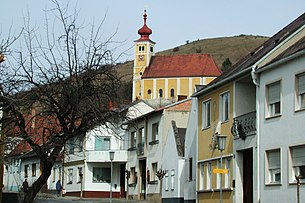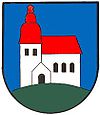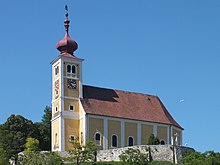Donnerskirchen
|
market community Donnerskirchen
|
||
|---|---|---|
| coat of arms | Austria map | |
|
|
||
| Basic data | ||
| Country: | Austria | |
| State : | Burgenland | |
| Political District : | Eisenstadt area | |
| License plate : | EU | |
| Surface: | 33.92 km² | |
| Coordinates : | 47 ° 54 ' N , 16 ° 39' E | |
| Height : | 193 m above sea level A. | |
| Residents : | 1,843 (January 1, 2020) | |
| Population density : | 54 inhabitants per km² | |
| Postal code : | 7082 | |
| Area code : | 02683 | |
| Community code : | 1 03 02 | |
| NUTS region | AT112 | |
| UN / LOCODE | AT NNN | |
| Address of the municipal administration: |
Hauptstrasse 29 7082 Donnerskirchen |
|
| Website: | ||
| politics | ||
| Mayor : | Johannes Mezgolits ( ÖVP ) | |
|
Municipal Council : ( 2017 ) (21 members) |
||
| Location of Donnerskirchen in the Eisenstadt-Umgebung district | ||
 Town center with St. Martin's mountain church |
||
| Source: Municipal data from Statistics Austria | ||
Donnerskirchen is a market town with 1843 inhabitants (as of January 1, 2020) in Burgenland in the Eisenstadt-Umgebung district in Austria . The Hungarian place name of the municipality is Fertőfehéregyháza .
geography
Geographical location
The community is located in northern Burgenland near the state capital Eisenstadt .
Parts of the municipality are located in the Neusiedlersee - Leithagebirge nature park .
Neighboring communities
Their neighboring communities are Purbach am Neusiedler See in the north, Schützen am Gebirge and Oggau in the south and Hof am Leithaberge in the northwest.
Community structure
Donnerskirchen is a town and a cadastral community at the same time. The only district is the hamlet of Seehof in the southeast of Donnerskirchen .
history
Before the birth of Christ, the area was part of the Celtic Kingdom of Noricum and belonged to the surroundings of the Celtic hill settlement Burg on the Schwarzenbacher Burgberg .
At the foot of the Leithagebirge in a were emergency excavation of the Landesmuseum Burgenland in the hallway Wolfbach Ried two inhumations from the Latènezeit exposed and sheltered. The two rectangular shafts were carved into the sand-lime brick and provided with wooden cladding. A man between the ages of 50 and 70 was buried in one grave, and a woman between 60 and 80 years of age in the other. The graves were oriented in a south-north direction and were already robbed when they were discovered. In the men's grave an iron lance tip, a lance shoe, a razor and two whetstones, an incomplete iron brooch , a clay bowl, a clay bottle and some fragments that belonged to an iron sword scabbard were found as grave goods. The excavators found four bronze brooches, a finger ring, a bowl and two clay bottles in the women's grave.
Later under the Romans, today's Donnerskirchen was then in the province of Pannonia . The Amber Road , one of the most important trade routes of the Roman Empire, runs to the east of the municipality on the edge of the Neusiedlersee reed belt .

1659 Donnerskirchen was Emperor Leopold I , the market law awarded.
Like all of Burgenland, the place belonged to Hungary (German-West Hungary) until 1920/21 . Since 1898 had due to the Magyarization of the government in Budapest of Hungarian name Sopronfehéregyháza be used. After the end of the First World War , after tough negotiations, German-West Hungary was awarded to Austria in the Treaties of St. Germain and Trianon in 1919. The place has belonged to the newly founded federal state of Burgenland since 1921 (see also the history of Burgenland ).
During the Second World War , Donnerskirchen was part of the central section (Eisenstadt) of the south-east wall to be built . In the Donnerskirchen camp (special camp for Hungarian-Jewish forced laborers), acts of extreme cruelty occurred at the end of 1944, during the subsequent persecution of which the condemnation of the construction site manager Nikolaus Schorn received particular public attention. According to estimates by local residents, 300 to 400 people are said to have died in the Donnerskirchen camp.
Population development

Culture and sights
- Donnerskirchen burial mound
- Parish church Donnerskirchen : The baroque building was consecrated in 1680. The landmark of Donnerskirchen is elevated above the place. The church, also known as the mountain church, was thelast place of refuge for the local populationin times of war (e.g. during the Turkish sieges ).
- The Catholic branch church St. Johannes Nepomuk in the town center from 1783 owns a high altar from the Augustinian monastery in Bruck an der Leitha .
- The historic Leisserhof goes back to Freiherr Christoph Leisser von Idolsberg and Kronseck. In 1653 the Esterházys acquired the Leisserhof and used it as their central wine store. When the St.Martinus Winzer-Genossenschaft acquired it from the municipality of Donnerskirchen in 1956, the name Martinsschlössl also came up. In 2014 the farm was leased to the Genuss Burgenland association , which renovated it and now operates it under the name Martinsschlössl .
- The Sonnenwaldbad in the western part of the village has had two stainless steel pools since 2002. A baby pool and one with five 25 m lanes and a 4 m high 38.5 m long GRP slide. Camping, skateboard park, tennis courts and a mobile home park are adjacent. Before - from 1970 - there were 3 concrete pools here, with a diving board and a water depth of 3.6 m.
- The mountain church of Donnerskirchen is a frequent venue for concerts by the violinist and composer Toni Stricker .
- Pillory with a sword and stone ball on a chain for the leg of the person to be punished, from 1660 on the main road.
music
- Music Association 1. Burgenland Trachtenkapelle Donnerskirchen,
- St. Martinus Choir,
- Gordon Highlanders of Austria,
- D 'Original Sautanz-Musi,
Economy and Infrastructure
The community on the eastern slope of the Leithagebirge is primarily known for its internationally distinguished winemakers and their top-quality wines. In spring the area impresses with the numerous cherry trees in bloom.
traffic
- Donnerskirchen is on Burgenland Strasse (B 50) and is the starting point for Mannersdorfer Strasse (B 15).
- With the Pannoniabahn , the community also has a connection to the Ostbahn with direct connections to Vienna.
politics
Municipal council
The council comprises a total of 21 members on the basis of population.
| Political party | 2017 | 2012 | 2007 | 2002 | 1997 | ||||||||||
|---|---|---|---|---|---|---|---|---|---|---|---|---|---|---|---|
| Sti. | % | M. | Sti. | % | M. | Sti. | % | M. | Sti. | % | M. | Sti. | % | M. | |
| ÖVP | 757 | 63.67 | 14th | 707 | 54.13 | 11 | 574 | 46.78 | 10 | 558 | 47.05 | 9 | 403 | 38.38 | 7th |
| SPÖ | 432 | 36.33 | 7th | 599 | 45.87 | 10 | 575 | 46.86 | 11 | 517 | 43.59 | 9 | 460 | 43.81 | 9 |
| FPÖ | not running | not running | 31 | 2.53 | 0 | 111 | 9.36 | 1 | 187 | 17.81 | 3 | ||||
| FBL | not running | not running | 47 | 3.83 | 0 | not running | not running | ||||||||
| Eligible voters | 1664 | 1593 | 1511 | 1408 | 1291 | ||||||||||
| voter turnout | 81.01% | 88.95% | 89.08% | 91.12% | 89.93% | ||||||||||
Parish council
In addition to Mayor Johannes Mezgolits (ÖVP) and Vice Mayor Elmar Rohrer (SPÖ), the executive councilors Josef Bayer (ÖVP), Simone Braunstein (ÖVP), Franz Fuhrmann (ÖVP), Monika Graf-Rohrer (SPÖ) and Johannes Udulutsch (ÖVP) to the community council.
The community treasurer is Michael Hoffmann (ÖVP).
mayor
Mayor is Johannes Mezgolits (ÖVP), who in 2012 succeeded Josef Frippus (SPÖ), who has headed the municipality since 1992. In the direct mayor election on October 1, 2017, Mezgolits was confirmed in his office with 66.23% of the votes. His competitor Hans-Peter Hasieber (SPÖ) received 33.77%. Hasieber thereupon announced his waiver of a municipal council mandate, which is why Elmar Rohrer (SPÖ) was elected vice mayor at the constituent meeting of the municipal council.
Head of office is Christoph Gänsbacher.
Chronicle of the judges and mayors
|
|
|
|||||||||||||||||||||||||||||||||||||||||||||||||||||||||||||||||||||||||||||||||||||||||||||||||||||||||||||||||||||||||||||||||||||||||||||||||||||||||||||||
coat of arms
In blue on a background of silver, a red-roofed church, with three open arched windows and a magnificent tower, the roof of which is detached and decorated with a cross.
Personalities
- Herbert Janata (* 1940), as a member of the Worried Men Skiffle Group, holder of the Silver Medal of Merit of the State of Vienna
- Sebastian Janata (* 1988), writer, musician, producer and member of the group " Ja, Panik "
- Hans Krenn (* 1934), painter and writer
- Rudolf Kroboth (1887–1964), politician and farmer
- Andreas Liegenfeld (* 1964), politician and winegrower
- Franz Strobl (1897–1980), politician and government forest director
- Isabella Mayer (* 1992) Austrian wine queen
literature
- Stefan Ehrenreiter, Ludwig Fingerhut, Simone Rosenitsch (Red.): Chronicle Donnerskirchen 1285–2010 . Tourism Association Donnerskirchen, Donnerskirchen 2010.
- Michael Achenbach, Dieter Szorger: The deployment of Hungarian Jews on the southeast wall in the Lower Danube section 1944/45. Thesis. University of Vienna, Vienna 1997, OBV .
- Gisela Auer (Red.): Home book of the market town Donnerskirchen. Market town of Donnerskirchen, Donnerskirchen 1985, OBV .
- Gisela Auer: The irregulars in Donnerskirchen in autumn 1921. In: Burgenland homeland sheets . Volume 41, 1979. Office of the Burgenland Provincial Government, Provincial Archives and Provincial Library, Eisenstadt 1979, ZDB -ID 214233-8 , pp. 25–30, OBV , PDF on ZOBODAT
- Rudolf Kleiner: Chronicle of the community Donnerskirchen. Self-published, Donnerskirchen 1973, OBV .
Web links
- 10302 - Donnerskirchen. Community data, Statistics Austria .
- donnerskirchen.at
- chronik-donnerskirchen.at
Individual evidence
- ^ Susanne Sievers / Otto Helmut Urban / Peter C. Ramsl: Lexicon for Celtic Archeology. A-K and L-Z ; Announcements of the prehistoric commission in the publishing house of the Austrian Academy of Sciences , Vienna 2012, ISBN 978-3-7001-6765-5 , p. 433.
-
^ The monster of Donnerskirchen. The bestialities of the mass murderer Schorn . In: Burgenland freedom . XXI. Year, No. 38/1951, ZDB -ID 2588385-9 , p. 1, bottom center. - Full text online ,
life sentence for the mass murderer von Donnerskirchen . In: Burgenland freedom . XXI. Volume, No. 39/1951, p. 2, bottom left. - Full text online as well as
Wolfgang Neugebauer (Ed.), August Ernst (contributions): Resistance and persecution in Burgenland. 1934–1945, a documentation. Published by the Documentation Archive of the Austrian Resistance . 2nd Edition. Österreichischer Bundesverlag (among others), Vienna 1983, ISBN 3-215-02259-1 , p. 333 ff. - ^ Eleonore Lappin-Eppel: Special camp for Hungarian-Jewish forced laborers. In: Wolfgang Benz , Barbara Distel (eds.): The place of terror . History of the National Socialist Concentration Camps. Volume 9: Labor education camps, ghettos, youth protection camps, police detention camps, special camps, gypsy camps, forced labor camps. CH Beck, Munich 2009, ISBN 978-3-406-57238-8 , pp. 230-233. - text online .
- ↑ The Martinsschlössl. Retrieved March 14, 2019 .
- ↑ a b Results of the 2017 municipal council elections in Donnerskirchen. Office of the Burgenland Provincial Government, October 29, 2017, accessed on January 17, 2020 .
- ^ Election results for the 2012 municipal council election in Donnerskirchen. Office of the Burgenland Provincial Government, November 4, 2012, accessed on January 17, 2020 .
- ^ Election result of the 2007 municipal council election in Donnerskirchen. Office of the Burgenland Provincial Government, October 21, 2007, accessed on January 17, 2020 .
- ↑ a b Results of the local council election 2002 in Donnerskirchen. Office of the Provincial Government of Burgenland, October 21, 2002, accessed on January 17, 2020 .
- ↑ a b c Marktgemeinde Donnerskirchen: Municipal Council (accessed on December 12, 2017)
- ↑ Marktgemeinde Donnerskirchen: Municipal Office (accessed on December 12, 2017)
- ↑ a b c Geschichts- und Kulturverein Donnerskirchen: Granting of market rights (accessed on December 12, 2017)










